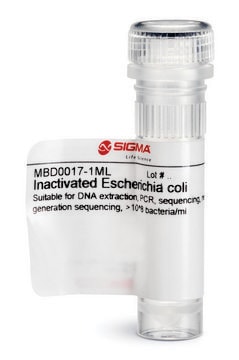The cells in this product are expected to be viable and may grow in culture, but it's important to note that the product is not intended for culture use. The material is not handled aseptically during manufacturing, so it is likely that other organisms would be present. The main purpose of this product is to serve as a biomass, specifically for the extraction of biomolecules such as DNA and lipids. It's important to understand that there is no guarantee of viability or purity. If the end user wishes to reconstitute the product for culture, they should add 0.3 to 0.4 ml of suitable liquid medium/broth to the freeze-dried material and mix it well. Then, they should transfer the total mixture to a culture tube or plate containing 5 - 6 mL medium/broth. It's worth noting that there is no cell count estimate available for this product.
EC11303
Escherichia coli
Strain B, lyophilized cells
Synonym(s):
E. coli
About This Item
Recommended Products
Quality Level
sterility
non-sterile (not processed or packaged aseptically)
form
lyophilized cells
suitability
not intended for starter culture
storage temp.
−20°C
Looking for similar products? Visit Product Comparison Guide
Related Categories
General description
Storage Class Code
11 - Combustible Solids
WGK
WGK 3
Flash Point(F)
Not applicable
Flash Point(C)
Not applicable
Personal Protective Equipment
Choose from one of the most recent versions:
Certificates of Analysis (COA)
Don't see the Right Version?
If you require a particular version, you can look up a specific certificate by the Lot or Batch number.
Already Own This Product?
Find documentation for the products that you have recently purchased in the Document Library.
-
Could you provide the reconstitution method and concentration for product EC11303 under the brand SIGMA?
1 answer-
Helpful?
-
-
What is the method of reconstitution for this product and what is the concentration?
1 answer-
These cells are expected to be viable and may grow in culture. However, the product is not intended for culture use. The material is not handled aseptically during manufacturing, therefore other organisms would likely be present. The product is intended to serve as a biomass, i.e., for the extraction of biomolecules such as DNA and lipids. There is no guarantee of viability or purity. Should the end user wish to reconstitute the product for culture, add to the freeze-dried material 0.3 to 0.4 ml of suitable liquid medium/broth and mix well. Transfer the total mixture to a culture tube or plate containing 5 - 6 mL medium/broth. There is no cell count estimate available.
Helpful?
-
Active Filters
Our team of scientists has experience in all areas of research including Life Science, Material Science, Chemical Synthesis, Chromatography, Analytical and many others.
Contact Technical Service







